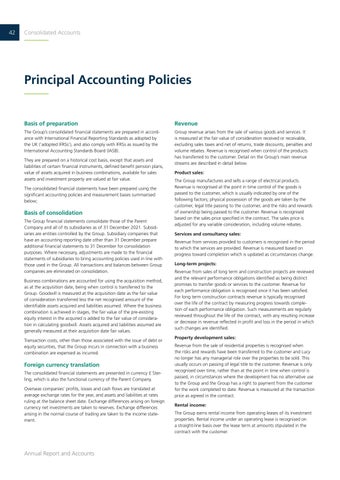42
Consolidated Accounts
Principal Accounting Policies
Basis of preparation
Revenue
The Group’s consolidated financial statements are prepared in accordance with International Financial Reporting Standards as adopted by the UK (‘adopted IFRSs’), and also comply with IFRSs as issued by the International Accounting Standards Board (IASB).
Group revenue arises from the sale of various goods and services. It is measured at the fair value of consideration received or receivable, excluding sales taxes and net of returns, trade discounts, penalties and volume rebates. Revenue is recognised when control of the products has transferred to the customer. Detail on the Group’s main revenue streams are described in detail below.
They are prepared on a historical cost basis, except that assets and liabilities of certain financial instruments, defined benefit pension plans, value of assets acquired in business combinations, available for sales assets and investment property are valued at fair value. The consolidated financial statements have been prepared using the significant accounting policies and measurement bases summarised below;
Basis of consolidation The Group financial statements consolidate those of the Parent Company and all of its subsidiaries as of 31 December 2021. Subsidiaries are entities controlled by the Group. Subsidiary companies that have an accounting reporting date other than 31 December prepare additional financial statements to 31 December for consolidation purposes. Where necessary, adjustments are made to the financial statements of subsidiaries to bring accounting policies used in line with those used in the Group. All transactions and balances between Group companies are eliminated on consolidation. Business combinations are accounted for using the acquisition method, as at the acquisition date, being when control is transferred to the Group. Goodwill is measured at the acquisition date as the fair value of consideration transferred less the net recognised amount of the identifiable assets acquired and liabilities assumed. Where the business combination is achieved in stages, the fair value of the pre-existing equity interest in the acquired is added to the fair value of consideration in calculating goodwill. Assets acquired and liabilities assumed are generally measured at their acquisition date fair values. Transaction costs, other than those associated with the issue of debt or equity securities, that the Group incurs in connection with a business combination are expensed as incurred.
Foreign currency translation The consolidated financial statements are presented in currency £ Sterling, which is also the functional currency of the Parent Company. Overseas companies’ profits, losses and cash flows are translated at average exchange rates for the year, and assets and liabilities at rates ruling at the balance sheet date. Exchange differences arising on foreign currency net investments are taken to reserves. Exchange differences arising in the normal course of trading are taken to the income statement.
Annual Report and Accounts
Product sales: The Group manufactures and sells a range of electrical products. Revenue is recognised at the point in time control of the goods is passed to the customer, which is usually indicated by one of the following factors; physical possession of the goods are taken by the customer, legal title passing to the customer, and the risks and rewards of ownership being passed to the customer. Revenue is recognised based on the sales price specified in the contract. The sales price is adjusted for any variable consideration, including volume rebates. Services and consultancy sales: Revenue from services provided to customers is recognised in the period to which the services are provided. Revenue is measured based on progress toward completion which is updated as circumstances change. Long-term projects: Revenue from sales of long term and construction projects are reviewed and the relevant performance obligations identified as being distinct promises to transfer goods or services to the customer. Revenue for each performance obligation is recognised once it has been satisfied. For long term construction contracts revenue is typically recognised over the life of the contract by measuring progress towards completion of each performance obligation. Such measurements are regularly reviewed throughout the life of the contract, with any resulting increase or decrease in revenue reflected in profit and loss in the period in which such changes are identified. Property development sales: Revenue from the sale of residential properties is recognised when the risks and rewards have been transferred to the customer and Lucy no longer has any managerial role over the properties to be sold. This usually occurs on passing of legal title to the customer. Revenue is only recognised over time, rather than at the point in time when control is passed, in circumstances where the development has no alternative use to the Group and the Group has a right to payment from the customer for the work completed to date. Revenue is measured at the transaction price as agreed in the contract. Rental income: The Group earns rental income from operating leases of its investment properties. Rental income under an operating lease is recognised on a straight-line basis over the lease term at amounts stipulated in the contract with the customer.









